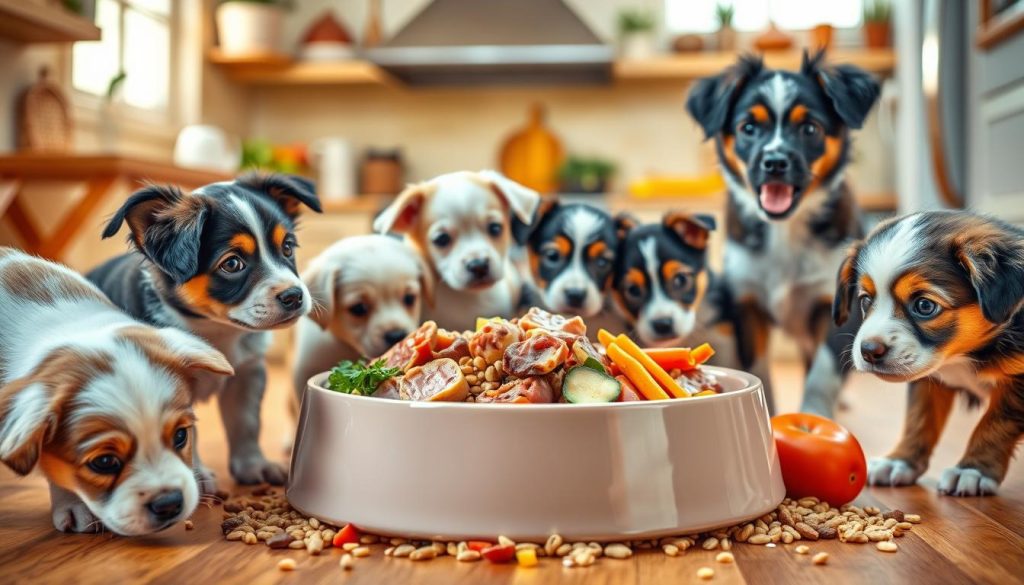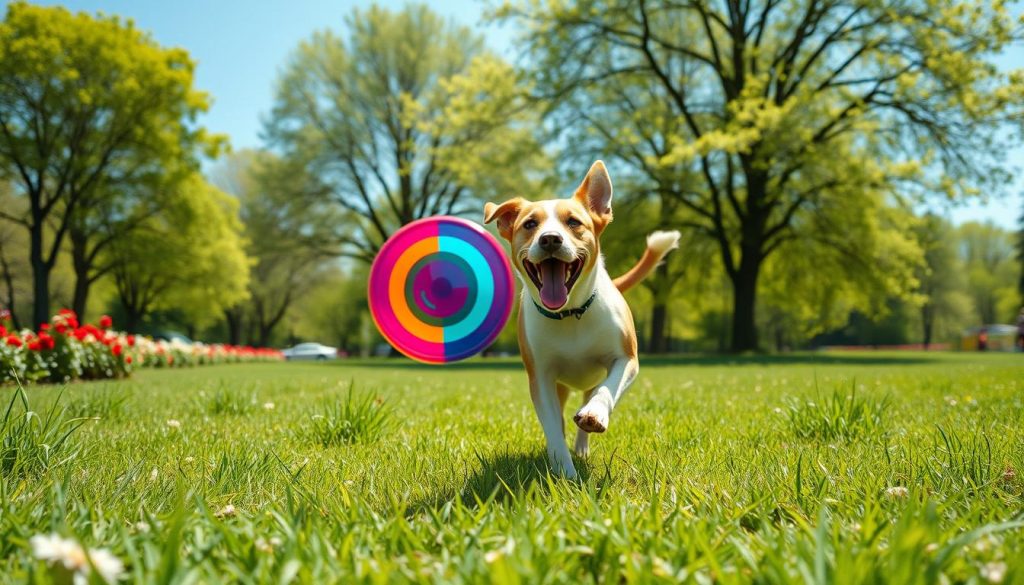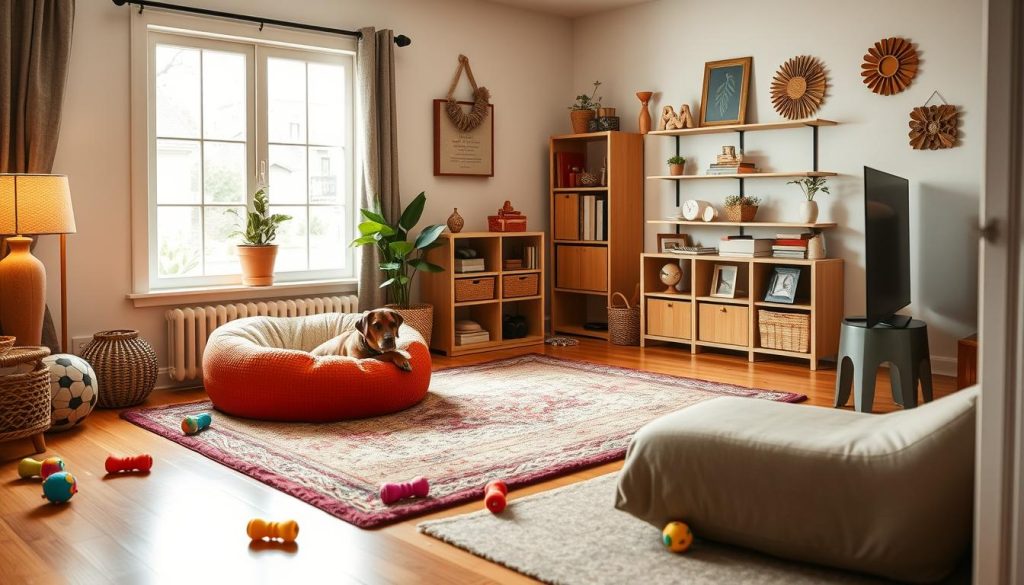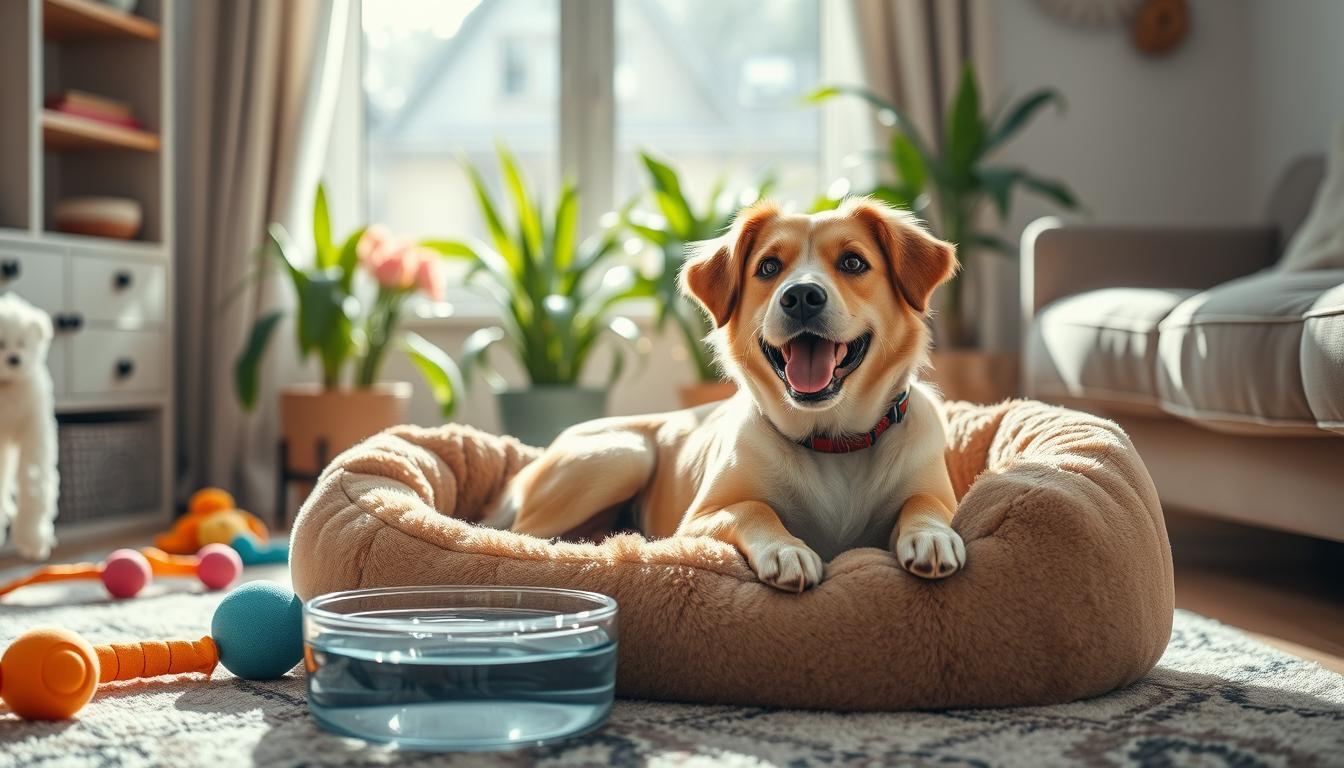Being a dog owner is a big responsibility. We must give our dogs the best care possible. This includes a regular routine, proper food, and enough exercise. I’ll share some tips that have kept my dog happy and healthy.
Keeping a routine is crucial for dog care. Dogs love knowing what to expect. By setting a schedule for walks, meals, and play, we make them feel safe and happy. Let’s explore how to create a good routine for your dog.
Establishing a Routine for Your Furry Friend
Consistency is key for a happy dog. A daily routine gives your dog a sense of security and promotes healthy habits. We’ll look at why consistency is important and how to create a schedule for walks, meals, and playtime.
Importance of Consistency in Dog Care
Dogs love predictability. A consistent routine makes them feel safe and reduces stress. Knowing what to expect helps them manage their energy and behave better.
Consistency also helps in training and setting rules. It makes it easier to teach your dog good habits.
Creating a Schedule for Walks, Meals, and Playtime
- Dog Walks: Regular walks, like morning, afternoon, and evening, help your dog understand when to go out.
- Mealtimes: Eating at the same times each day helps regulate their appetite and digestion.
- Playtime: Setting aside specific times for play keeps your dog mentally and physically active.
Creating a consistent routine makes your dog feel secure and comfortable. This strengthens your bond and makes your dog happier and healthier.
| Routine Element | Recommended Schedule |
|---|---|
| Dog Walks | Morning, Afternoon, Evening |
| Mealtimes | Breakfast, Lunch, Dinner |
| Playtime | 30-60 minutes per session, 2-3 times a day |
Providing Proper Nutrition for a Healthy Pup

Keeping your dog healthy starts with the right food. Knowing what your dog needs is key. They need proteins, fats, carbs, and vitamins to stay well.
Understanding Your Dog’s Dietary Needs
Dogs need different foods based on their age, breed, and how active they are. The right mix of proteins, fats, and carbs is important. Always talk to your vet to find the best food for your dog.
Choosing High-Quality Dog Food and Treats
Quality matters when it comes to dog food and treats. Choose food with real ingredients and no bad stuff. Also, watch how much you give them to keep them healthy.
| Nutrient | Importance for Dogs |
|---|---|
| Protein | Supports muscle growth, maintenance, and repair. |
| Fats | Provide energy and aid in the absorption of fat-soluble vitamins. |
| Carbohydrates | Serve as a source of energy and support healthy digestion. |
| Vitamins and Minerals | Essential for maintaining overall health, immune function, and organ function. |
By knowing what your dog needs and choosing good food, you help them stay healthy. This way, they can live a happy and healthy life.
Dog care: Essential Grooming Practices
Keeping up with your dog’s grooming is key for their health and happiness. Regular dog grooming makes them look great and keeps them healthy. Here, we’ll cover the must-do grooming practices for every dog owner.
Bathing and Dog Hygiene
Bathing your dog is a big part of their grooming. Bathe them every 4-8 weeks, based on how active they are and their coat’s condition. Use a soft, dog-friendly shampoo to clean their skin and fur. Make sure to avoid their ears and rinse well to avoid skin problems.
Dog Brushing and Coat Care
Brushing your dog’s coat regularly is important. It removes loose hair, spreads natural oils, and keeps their fur in top shape. Brush them 1-3 times a week, depending on their breed and coat type. This keeps their dog grooming up and reduces shedding at home.
Dog Nail Trimming
- Trim your dog’s nails every 4-6 weeks to prevent overgrowth and discomfort.
- Use a pair of specialized dog nail clippers and be careful not to cut the quick, which is the sensitive blood vessel inside the nail.
- If you’re unsure, consult your veterinarian or a professional dog groomer for guidance on proper nail trimming techniques.
By following these essential dog grooming practices, you’ll keep your pet healthy, comfortable, and looking good. Remember, regular dog hygiene and grooming are key to being a good pet owner.
Exercising Your Dog for Physical and Mental Wellbeing

Keeping your dog happy and healthy is more than just food and shelter. They need regular exercise for their body and mind. You can try walks, playtime, and more to keep them fit and happy.
Different Types of Exercise for Dogs
Dogs love to move and are natural athletes. They enjoy walks, fetch, and swimming. Mixing these activities keeps them active and engaged.
- Walks: A daily walk is a great way to provide your dog with much-needed physical activity and mental stimulation.
- Fetch: This classic game is a fantastic way to get your dog’s heart rate up while also challenging their retrieval skills.
- Swimming: For dogs that enjoy the water, swimming is an excellent low-impact exercise that can help build muscle and endurance.
- Agility training: Agility courses challenge your dog’s physical and mental abilities, making it a rewarding activity for both of you.
Incorporating Mental Stimulation into Daily Activities
Physical exercise is key, but don’t forget mental stimulation. It keeps your dog happy and prevents boredom. Try these activities:
- Puzzle toys: Food-dispensing puzzle toys encourage your dog to problem-solve, keeping their mind active.
- Training sessions: Regular training, whether it’s mastering new commands or reinforcing existing ones, provides mental stimulation and strengthens the bond between you and your dog.
- Scent work: Engaging your dog’s powerful sense of smell through hide-and-seek games or scent detection exercises can be a great way to challenge their mind.
Combining physical and mental exercises ensures your dog’s wellbeing. A well-exercised and mentally active dog is a happy and well-behaved friend.
Creating a Safe and Comfortable Environment

As a responsible dog owner, making your home safe and cozy for your furry friend is key. Puppy-proofing your home is the first step to a secure space. Also, providing comfortable dog bedding and beds can boost your pup’s happiness.
Puppy-Proofing Your Home
Protecting your home from dog safety risks is vital, especially with a new furry family member. Look for and fix any dangers, like exposed cords, toxic plants, or small items that can be swallowed. Use baby gates, cover sharp edges, and keep cleaning products and meds out of reach.
Creating a puppy-proofed home keeps your dog safe and gives you peace of mind. By being proactive, you can lower the risk of accidents and ensure your pup’s safety as they explore their new space.
Providing Cozy Sleeping Spaces
It’s important to offer your dog comfy sleeping areas for their well-being. Choose soft, supportive dog beds and bedding that fit your pup’s size and likes. Having multiple spots for your dog to sleep can let them pick their favorite place.
By making your home safe and comfy, you’re setting the stage for a happy, healthy dog. Investing in dog-friendly home features and cozy sleeping spots greatly improves your dog’s happiness and well-being.
Socializing Your Dog for Positive Behavior
Socializing your dog is key to being a good dog owner. By slowly introducing them to new things, people, and places, you help them grow up well-adjusted. This way, they’ll have a happy life filled with good interactions. Here are some tips to help socialize your dog for a better life.
Start Early and Consistently
The best time to socialize a dog is when they’re young. Puppies are very open to new things during the first few months. Introduce them to different people, animals, and places in a good way. Keep up with socializing them as they grow to keep them feeling comfortable and confident.
Positive Reinforcement is Key
Always use positive ways to socialize your dog. Give them treats, praise, and love when they act calm and friendly. This makes them think these new things are fun, not scary.
Gradually Expand Their Horizons
Begin with quiet places like neighborhood walks or visits with friends. As they get more comfortable, take them to busier places. This step-by-step approach helps them feel more confident and positive.
Seek Out Dog-Friendly Environments
Find places in your area that are good for dogs. These spots let your dog meet other dogs and their owners. Dog training classes or dog walking groups are also great ways to socialize your dog.
By focusing on socializing your dog, you help them become a friendly and confident pet. With patience, consistency, and positive rewards, you’ll ensure they have a happy life filled with good interactions.
| Socialization Tip | Benefits |
|---|---|
| Start early and be consistent | Puppies are highly impressionable, and consistent socialization throughout their life helps maintain their comfort and confidence |
| Use positive reinforcement | Rewarding calm and friendly behaviors creates positive associations with new experiences |
| Gradually expand their horizons | Slowly introducing your dog to more stimulating environments builds their confidence and comfort level |
| Seek out dog-friendly environments | Participating in dog-friendly activities and events provides opportunities for your pup to socialize with other dogs and people |
Preventive Care: Vaccinations and Veterinary Visits
Keeping my dog healthy is very important to me. Preventive care helps them stay happy and healthy. It’s key to keep up with their vaccinations to protect them from serious diseases.
Regular vet visits help catch health problems early. This way, my dog gets the care they need to live a long, happy life.
Vet visits are important for vaccinations and health checks. They also help monitor weight and discuss nutrition and behavior. I work with my vet to make a care plan that fits my dog’s needs.
By focusing on vaccinations and vet care, I know my dog is well-protected. This care plan gives me peace of mind. It ensures my dog lives a happy, healthy life with me.

